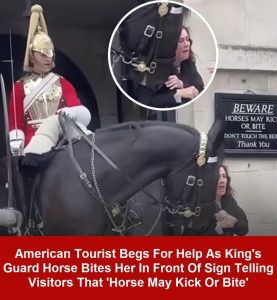Many travelers enjoy getting an up-close experience with the King’s Guard when visiting England. These iconic guards, known for their striking red uniforms and tall bearskin hats, serve as a major tourist attraction, especially at locations such as Buckingham Palace and Windsor Castle. The allure of witnessing these highly disciplined soldiers up close often leads visitors to test the limits of interaction, even when they are well aware that physical contact is not permitted.

One American tourist, in particular, found herself in an unexpected and painful situation when she approached one of the King’s Guards during her visit to Buckingham Palace. The guards, primarily composed of active-duty military personnel, are stationed at various royal buildings to protect these historic sites and maintain order. Their commitment to duty is unwavering, and they are trained to remain composed and focused, regardless of outside distractions. This dedication, however, can sometimes make them seem unapproachable or indifferent to the public.
On the day of the incident, the American tourist stepped too close to one of the guards on horseback. Without warning, the horse, trained to remain still but always alert, suddenly bit her arm. The woman’s reaction was immediate and loud, as she cried out in pain. A video captured the distressing moment, where her panicked voice could be heard shouting: “Ow! Ow! Help me, he’s got my arm!” The grip of the horse’s teeth was firm, and her desperate pleas for assistance echoed through the crowd.
Despite her visible distress, the King’s Guard did not move from his position. He remained stoic on horseback, displaying no reaction to the unfolding event. The other guards, adhering strictly to their disciplined protocol, also did not intervene. Instead, they continued their duties as if nothing had happened. It was only when a few bystanders rushed over and gently patted the horse’s nose that the animal finally released its grip, allowing the woman to pull her arm away.
This incident sparked mixed reactions among those who witnessed it. Some spectators were shocked by the guard’s lack of response, questioning whether the adherence to protocol should extend to situations where a visitor is clearly in distress. Others, however, defended the King’s Guard, pointing out that their primary role is not to interact with tourists but to maintain security and order. The soldiers are trained to remain focused on their responsibilities, which include standing at attention, patrolling designated areas, and handling potential security threats. While this strict discipline is essential for the role they serve, situations like this raise questions about whether exceptions should be made in cases where someone is in immediate harm.
@busk1976 #horseguardsparade #householdcavalry #thekingsguard #royal #england #british #history #london #londontiktok #tourist #horsesontiktok #horsesoftiktok #fyp #soldier #horse ♬ original sound – Buska in the park
This was not the first time that a tourist had been involved in an incident with one of the King’s Guard horses. Over the years, numerous visitors have found themselves at risk due to their proximity to these animals. The horses, while highly trained, remain living creatures with natural instincts. If startled, they may react unpredictably by biting, kicking, or making sudden movements. This is why tourists are often warned not to touch or get too close to the guards or their horses. Unfortunately, many people ignore these warnings, often in an attempt to capture the perfect photo or video.
Tourists frequently try to provoke reactions from the King’s Guard, despite clear rules discouraging such behavior. Some visitors attempt to make them laugh, speak, or break formation, unaware that these soldiers are bound by strict military discipline. While this usually results in nothing more than an awkward standoff, there have been cases where the guards have been forced to react, especially when personal space is invaded. In some situations, guards have issued stern verbal warnings or even physically moved tourists away when they have gotten too close.
The presence of these guards is not just for ceremonial purposes; they are real soldiers, trained for serious defense. Their unwavering discipline serves a purpose beyond aesthetics—it ensures that security is maintained at all times. However, this particular event highlights the fine balance between strict adherence to duty and practical responsiveness to unforeseen circumstances.
In light of incidents like these, many have debated whether additional measures should be put in place to ensure visitor safety. Some have suggested the introduction of clearer barriers to prevent tourists from getting too close to the horses. Others believe that guards should be trained to intervene in exceptional cases where an individual is clearly in distress. However, implementing such changes could also compromise the traditional role and discipline of the King’s Guard, making this a complex issue with no easy solution.
Despite these concerns, Buckingham Palace and other royal sites continue to attract millions of visitors every year. The appeal of seeing the King’s Guard up close remains a major draw, and most tourists leave with nothing more than photos and fond memories. Incidents like the one involving the American tourist serve as reminders that, while these traditions are fascinating, they also come with responsibilities—both for those who serve as guards and for the visitors who interact with them.
Ultimately, the incident underscores an important lesson about respecting boundaries, particularly when dealing with animals in official capacities. While the King’s Guard horses are well-trained, they are still capable of unexpected behavior. Tourists must remember that these animals are not there for entertainment, and approaching them without caution can have unintended consequences.
For visitors planning a trip to Buckingham Palace or other royal sites, it is advisable to follow the posted guidelines and respect the space of both the guards and their horses. By doing so, they can enjoy the experience without putting themselves at unnecessary risk. Awareness and caution are key, ensuring that interactions remain safe and enjoyable for everyone involved.
While the American tourist’s unfortunate encounter was undoubtedly painful, it serves as a reminder of the discipline and structure that define the role of the King’s Guard. Their unwavering commitment to duty is a testament to their training and professionalism. However, the incident also raises important discussions about how strict adherence to protocol should be balanced with real-world responsiveness. It is a debate that is likely to continue, especially as tourism and security needs evolve.
In the end, the best approach for tourists is to admire the King’s Guard from a respectful distance. While the temptation to interact with them may be strong, respecting their role and maintaining awareness of their surroundings will ensure a safe and memorable visit. Understanding and respecting these historic traditions will allow visitors to appreciate them fully—without unexpected surprises.





